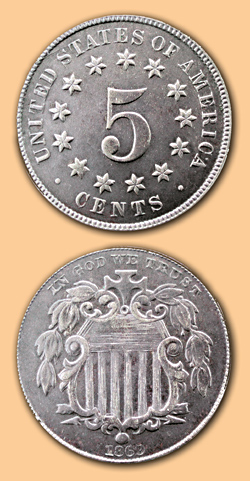|
"Making Cents"
The Signal
Saturday, August 19, 2006
| O |
Under the Act of May 16, 1866, Congress authorized a new composition for the 5-cent coin — an alloy of 75 percent copper and 25 percent nickel. At the time, the cost per coin was about 1 cent. The new coin was 5 grams in weight and the same size as today's 5-cent coins. The new design was executed by James B. Longacre, best known for his Indian head cent design of 1859. It was one of only four coins of the 19th Century that did not feature Miss Liberty in one form or another — the other three being the Flying Eagle cent of 1856-58, the 2-cent piece of 1864-1873 and the 3-cent silver piece of 1851-73.
The front of the new 5-cent coin featured a shield with two olive wreaths above and a Maltese-style cross above. The motto, "In God We Trust," which started in 1864 on the 2-cent coin, appeared atop the shield.
The word "Liberty" was omitted, which was strange, since it was an integral part of nearly all coins to that point. It was also omitted on the Flying Eagle cent, 2-cent piece and 3-cent silver coin.
The Mint produced both types of 5-cent coins, the shield nickel and the half dime, for an overlapping period of 1866-73. The nickel version ran until 1883. By then, nearly all of the silver 5-cent pieces had vanished from circulation.
Since all foreign coins were demonetized prior to the Civil War, their U.S. Mint counterparts had to fill in the economic niche across the fast-growing country. Foreign silver coins were still used in general commerce along with privately mint gold coins in the Western territories until much later, but as more U.S. Mint coinage spread across the country — including coins from the newly opened San Francisco Mint (1854) and Carson City Mint (1870) — the use of foreign coins declined to zero by the end of the century.
The 75-percent copper and 25-percent nickel alloy has held up until this year (2006), when metal prices pushed the actual cost of a 5-cent coin above five cents. In a move sure to come, the 5-cent nickel will get a makeover soon — either made smaller, made of cheaper alloy or both.
So, the nickel 5-cent coin may have run its course in the 140 years of mintage. That's considered quite a success in numismatic terms.
As a collector series, most dates are fairly inexpensive, especially in used condition. The very low mintage years of 1877-81 are quite scarce and command a huge premium in all grades. There are also quite a few recognized varieties that collectors actively seek out, including doubled dies and overdates.
This short-lived series was replaced in 1883 with the better-known "V" nickel of Charles Barber's design. The Roman numeral "V" was used for the first time on a U.S. coin to represent the numeral "5."
Dr. Sol Taylor of Sherman Oaks is president of the Society of Lincoln Cent Collectors and author of The Standard Guide to the Lincoln Cent. Click here for ordering information.
©2006, THE SIGNAL · ALL RIGHTS RESERVED.

![[Most Recent Quotes from www.kitco.com]](http://www.kitconet.com/images/quotes_special.gif)

